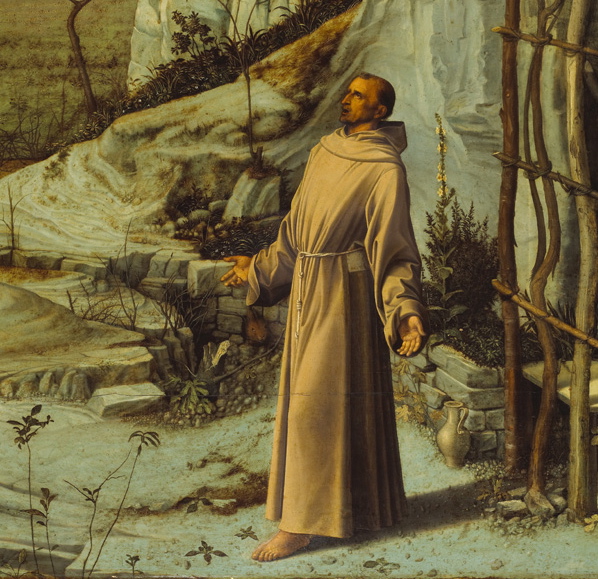 Giovanni Bellini, St. Francis in Ecstasy, 1480 (detail)
Giovanni Bellini, St. Francis in Ecstasy, 1480 (detail)
Oil and tempera on poplar panel
The Frick Collection, New York
Giovanni Bellini’s St. Francis in Ecstasy, in the Frick Collection, has been my favorite painting since I first saw it when I was around 13 years old. When I stood in front of St. Francis for the first time it really hit me: art has power. Bellini’s painting reached out to me in a way no other painting had until that moment. It was incredibly beautiful—the composition, the color, the landscape, the compelling figure of St. Francis—everything was in perfect sync. Even on that first viewing, I knew it was rich with meaning, both tangible and symbolic, and that it would draw me back again and again. It made me want to be a painter.
I have a drawer full of post cards of it, most of them now faded and tattered (no matter, this luminous painting, in spite of technological advances, has resisted all attempts at reproduction, no photograph captures the light that emanates from this masterpiece and the color is always off—too cold, too blue, too yellow, too dark.) Every time I visit the Frick, I buy another post card, as witness to the fact that I was fortunate to see it again and because I always want to take a little piece of it home with me. When I lived in New York, I would drop in for a few minutes whenever possible to spend some quiet moments in its light. Now, when I visit New York, it’s always the first stop on my itinerary. (Obviously the Frick is filled with treasures—but St. Francis is always the first and last painting I visit.)
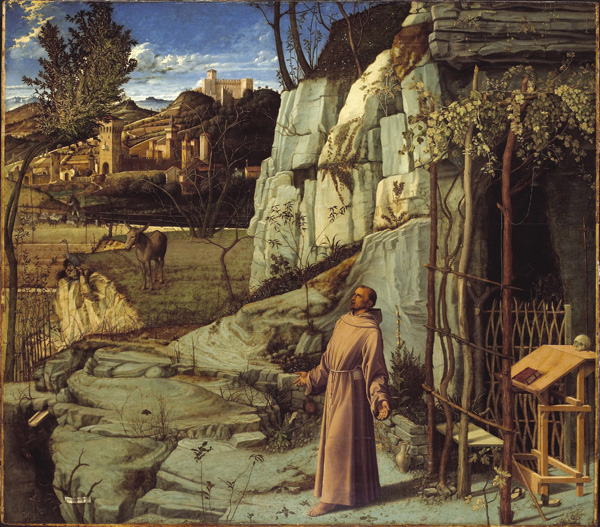 Giovanni Bellini, St. Francis in Ecstasy
Giovanni Bellini, St. Francis in Ecstasy
acquired by H.C. Frick, 1915
Some years ago, I was surprised to notice that the title of the painting had been changed to St. Francis in the Desert. At first, I was tempted to seek an explanation, but then decided I didn’t really want to know—perhaps there was some scholarly reason, the curators deciding that the setting in the desert, with all its powerful symbolism, took precedence; or perhaps there had been some error in translation that was now corrected? What I feared is that the word ecstasy was deemed too potent, too provocative. Below is the definition of ecstasy, and it seems exactly right to me:
Ecstasy: The state of being beside one’s self or rapt out of one’s self; a state in which the mind is elevated above the reach of ordinary impressions, as when under the influence of overpowering emotion; an extraordinary elevation of the spirit, as when the soul, unconscious of sensible objects, is supposed to contemplate heavenly mysteries.
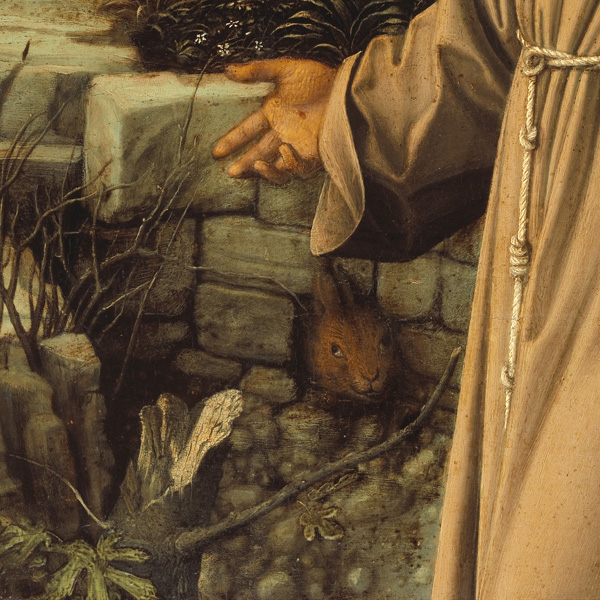 Giovanni Bellini, St. Francis in Ecstasy (detail)
Giovanni Bellini, St. Francis in Ecstasy (detail)
Giovanni Bellini (c. 1430-1560), a master of Venetian art, was from a family of painters. He studied in the workshop of his father, Jacopo Bellini, and in 1483 succeeded his brother Gentile Bellini as painter to the Republic. His brother-in-law was the great Andrea Mantegna. Giovanni Bellini was one of the first Italian painters to master the oil painting techniques perfected in Northern Europe by the early Netherlandish painters, Jan van Eyck and Rogier van der Weyden.
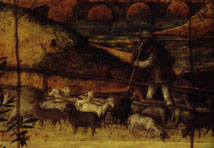 Giovanni Bellini, St. Francis in Ecstasy (details)
Giovanni Bellini, St. Francis in Ecstasy (details)
In St. Francis, as in his other sacred paintings, Bellini imbues the landscape with spiritual meaning. For Bellini, landscape did not only set the emotional tone and dictate the composition—it was symbolic of God’s presence in all of nature. Set in this profound landscape is the figure of St. Francis, slightly to the right of center, leaning back, arms open, gazing upward toward the mysterious light in the upper left-hand corner. The laurel tree, symbol of Christ’s cross, trembles and glows in this light and leans into the picture, towards St. Francis. The painting is filled with symbols of Christ’s Passion—the skull, the crown of thorns, the Bible, the grapevines. Every rock, animal and flower holds symbolic meaning for the Franciscan scholar. St. Francis stands barefoot, his sandals removed—he is standing on sacred ground.
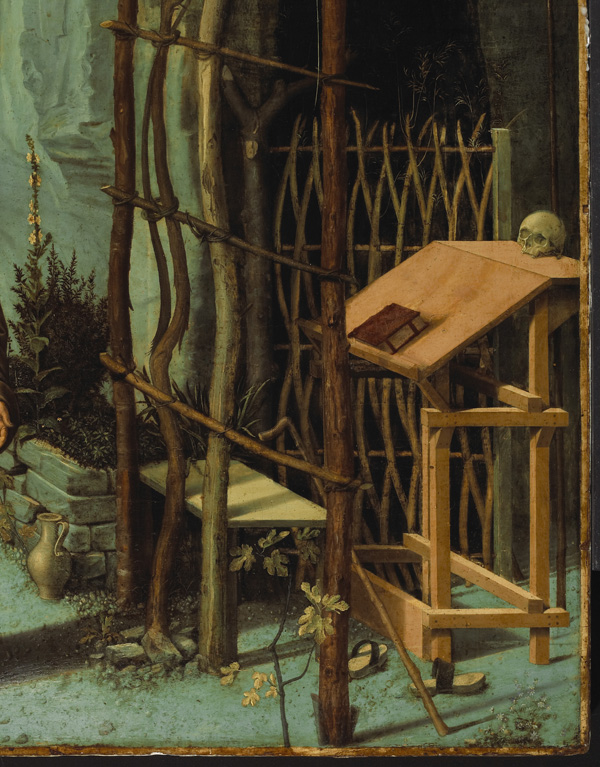 Giovanni Bellini, St. Francis in Ecstasy (detail)
Giovanni Bellini, St. Francis in Ecstasy (detail)
St. Francis is believed to have received the Stigmata in September of 1224 on Mount Alverna in the Apennines, where he retreated to pray and fast in preparation for Michaelmas. St. Francis wanted to bear the signs of the Passion so he could better understand Christ’s suffering, and to show gratitude to God for the sacrifice of his Son for humanity’s redemption. Brother Leo, witness to the event, described the moment: Suddenly he saw a vision of a seraph, a six-winged angel on a cross. This angel gave him the gift of the five wounds of Christ.
In Bellini’s painting, we see the signs of the Stigmata, but they are subtle—I see this painting not as a narrative of the event, but as a portrait of St. Francis in communication with the divine. There are two sources of light in this painting—one, the diffuse naturalistic glow that bathes the entire landscape. Every particle of air, every creature, rock and flower, vibrates with a translucent inner light. Then there is the supernatural light emanating from the upper left hand corner—this is not the powerful light that Brother Leo describes that transmitted Christ’s wounds to St. Francis—this is a spiritual illumination. St. Francis is basking in God’s light and presence—this is the “still point in the turning world” that T.S. Eliot evokes in the first of his Four Quartets, Burnt Norton:
After the kingfisher’s wing
Has answered light to light, and is silent, the light is still
At the still point of the turning world.
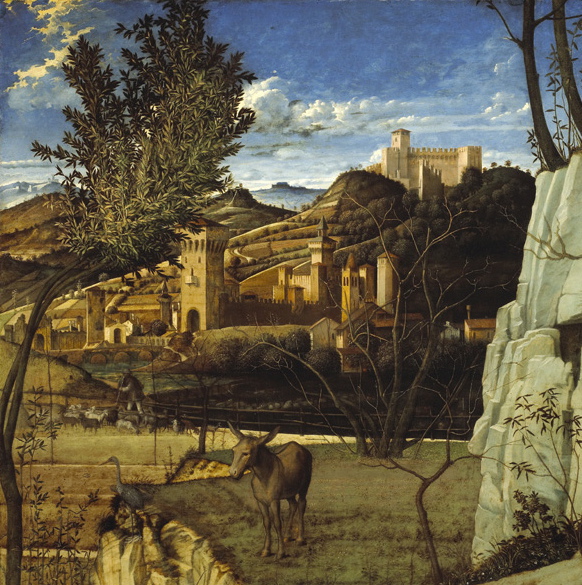
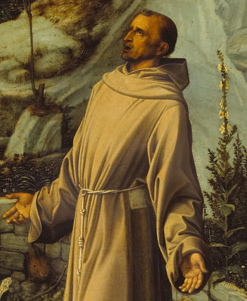
Fascinating. I never noticed the little rabbit peeking out of the wall. Thanks for the close-ups and your words about the light. I’ll have to visit the painting again when I’m next in NYC.
I visited the Frick collection today and saw this great painting. One aspect which is NOT coming through in the reproductions is that the rocky surface appearing above St. Francis is particularly bright, so as to keep drawing one’s attention to it. I was wondering whether this was because of some aging of the paint (maybe some of parts of the painting having become darker, making the rocky surface stand out), while my friend doubted that and suggested an intended visual opposition to the dark grotto. I’ve been searching the Internet for some information on this, can you comment? Thanks in advance.
Ben, I wish I could run over to the Frick to see in person what you are referring to, but I am 3000 miles away. I believe that the mysterious light from the upper left-hand corner of the painting that is bathing St. Francis in a transformative glow is also reflecting off the cliffs above him. I never found the cliffs distracting because I saw them as reflecting his moment in God’s light. The genius of Bellini was to make every inch of his landscapes reflect divine light, every creature and leaf resonates with the presence of God. For me, it is this genuine religious feeling, combined with such amazing skill, that makes Bellini stand out among the many great painters of his era.
For some reason, this painting resists being captured in a photograph—even recent reproductions do not do the painting any justice, they are murky and the color is either too cold or too blue or washed out.
hello, thank you for your nice post, it helped me understand more on this painting. (I arrived here searching comments on the painting after seing it thanks to the google art project.)
I agree- this painting is special, I’m a fan of Italian Rennaisance art and am familiar with most of the famous paintings but this one has only rescently come fully to my attention. There’ something about the light in it.
I was just telling someone yesterday that my favorite painting is Bellini’s ‘St. Francis in Ecstasy.’ I discovered your post when I went online making sure that I had remembered the correct title. My friend kept asking me what it was about the painting that so captivated me. The light was my answer. There is a certain time of day (near dusk) that the light outside reminds me of this painting and I always think of it. Like you, I too visit the Fricke and our favorite painting whenever I am in NY. Thank you for your very insightful comments.
I’m just in the middle of Michael Findlay’s The Value of Art and came across this relevant observation, taken from James Elkins Pictures and Tears: A History of People Who Have Cried in Front of Paintings
and came across this relevant observation, taken from James Elkins Pictures and Tears: A History of People Who Have Cried in Front of Paintings —
—
What an impact for the posters here. St. Francis in Ecstasy may be one of the most important paintings ever painted in a field of centuries of important paintings. I am a painter of almost fifty years and this masterpiece is as some of you have expressed as simultaneously enigmatic and tactile as God Himself.
hi christine, thank you for this insightful post about this great, great painting and artist. i have only recently discovered for myself bellini, having seen a madonna and child painting which though very much in the tradition of the icon painters also had a very unique beauty and mystery in the handling of paint and drawing that takes it far beyond that. i think this is the key to my enjoyment of him: the combination of the icon painters devotional passion and a painter keen to absorb the latest techniques and materials to better serve his craft. thanks again.
Thanks for your comment. I agree, Bellini’s work has a quality that is unique. Incredible skill and also enormous emotional and spiritual depth.
yes, ive been thinking alot about him of late. maybe you will enjoy this:
http://thewhitepoems.wordpress.com/2013/04/14/sacred-allegory/
mark
Very beautiful, thank you.
I first learned about this painting in college while taking a class in Italian Rennaisnace art. We took a class trip to New York and visited the Met and the Frick. This painting blew me away and I still think about it often. I always make it a point to visit with this masterpiece whenever I am in New York.Words can’t really describe it. I am always struck at how such a “quiet” painting can be so powerful.